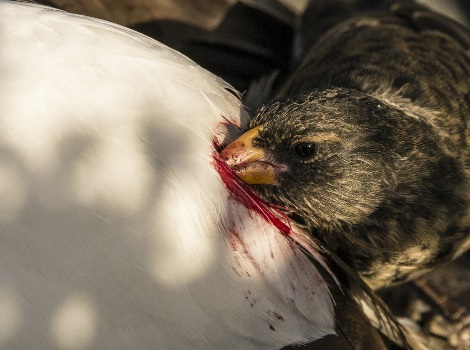Science
Related: About this forumEvolution in action detected in Darwin's finches
The most characteristic feature of Darwin's finches is the diversification of beak morphology that has allowed these species to expand their utilization of food resources in the Galápagos archipelago. A team of scientists from Uppsala University and Princeton University has now identified a gene that explains variation in beak size within and among species. The gene contributed to a rapid shift in beak size of the medium ground finch following a severe drought. The study is published in Science.

Darwin's finches are a classical example of an adaptive radiation. Their common ancestor arrived on the Galápagos about two million years ago. During the time that has passed the Darwin's finches have evolved into 18 recognized species differing in body size, beak shape, song and feeding behaviour. Changes in the size and form of the beak have enabled different species to utilize different food resources such us insects, seeds, nectar from cactus flowers as well as blood from seabirds, all driven by Darwinian selection. In a previous study from the same team the ALX1 gene was revealed to control beak shape (pointed or blunt) and now a gene (HMGA2) affecting beak size has been identified.
'Our data show that beak morphology is affected by many genes as is the case for most biological traits. However, we are convinced that we now have identified the two loci with the largest individual effects that have shaped the evolution of beak morphology among the Darwin's finches', says Sangeet Lamichhaney PhD student at Uppsala University and first author of the study.
Read more at: http://phys.org/news/2016-04-evolution-action-darwin-finches.html#jCp
northernsouthern
(1,511 posts)How did I not know about this?

NV Whino
(20,886 posts)The worst of The Birds and Twilight combined!
💀![]()
northernsouthern
(1,511 posts)One was, yeah, you didn't know?
The other was, you are lying, I sent her the image and now I think she is paranoid of birds.
longship
(40,416 posts)It took decades to accumulate their data. Their story is told in the absolutely wonderful book The Beak of the Finch. My sister turned me on to this book. It is a wonderful story of a singular dedication to studying nature and letting nature reveal its truths, just like Darwin did.
Only the Grants have done this for many years (since 1973) more than Darwin had any opportunity. It is an astounding story, which justifiably won a Pulitzer Prize for non-fiction.
R&K
![]()